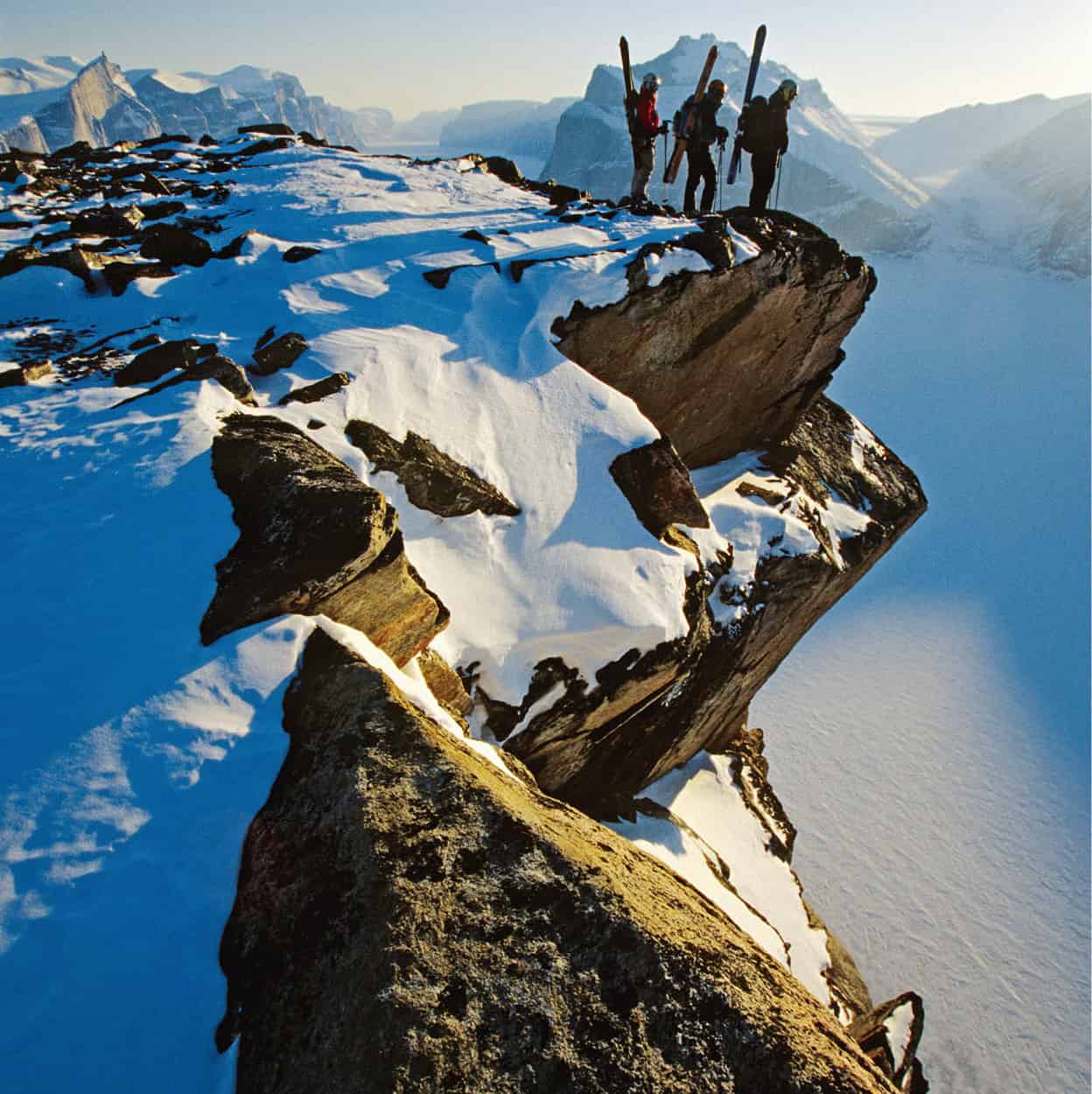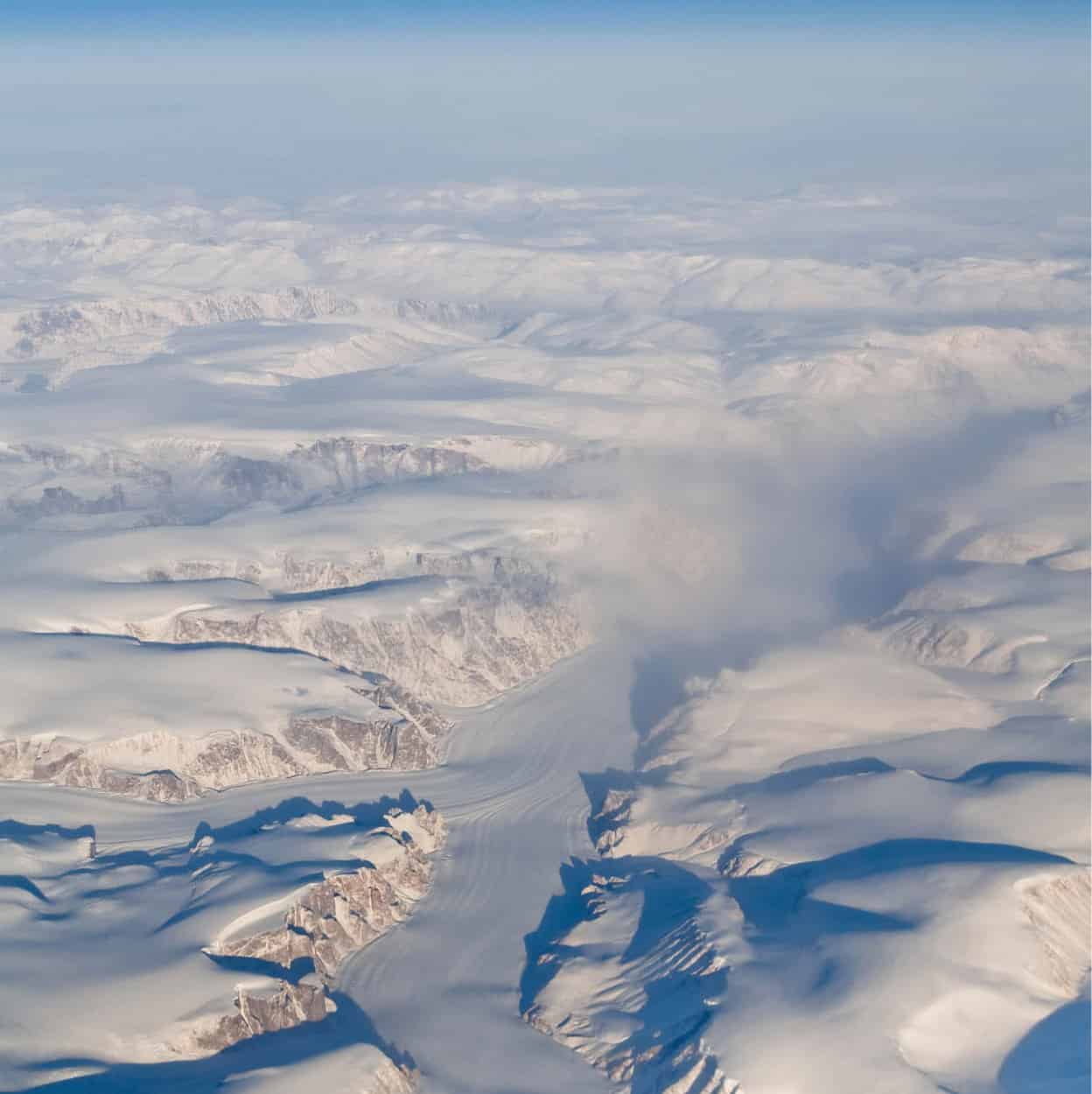The Eastern Arctic, including much of the Archipelago and the terrain east of Great Slave Lake, remained a hidden world until the age of the airplane. It became the new territory of Nunavut – which means “our land” in Inuktitut – on April 1, 1999, when the Northwest Territories were split into two. Approximately 85 percent of Nunavut’s population is Inuit and it had been vying for independence since 1973, driven by the desire for a self-governed territory with firm control over its own future. The Nunavut Land Claim Settlement, proclaimed in July 1993, is now regarded as a global benchmark in aboriginal matters and includes title to nearly 356,000 sq km (138,000 sq miles), mineral rights, a share of federal royalties on oil, gas, and mineral development on Crown lands, and the right of first refusal on sport and commercial development of Nunavut’s renewable resources.

Skiers admiring the view at Baffin Island.
Getty Images
The great outdoors
Canada’s newest territory is also its largest, occupying about 20 percent of the country’s land mass, almost entirely above the timber line and spread across three time zones. Nunavut extends from the eastern shores of Baffin and Ellesmere islands, west to the plateaus and cliffs of the Arctic coast on the Coronation Gulf, and north to the High Arctic Islands and the North Pole. It is home to various outpost settlements and 28 communities, the largest of which is the capital, Iqaluit, with a population of around 6,700 citizens.
Although isolated and expensive to get to, the delights of Nunavut’s great outdoors reward those who can afford the time and money to visit. As there are virtually no roads in Nunavut, other than a 21km (13-mile) stretch between Arctic Bay and Nanisivik, travel by air, snowmobile or dogsled are the only options. The challenging weather conditions may also mean frequent delays and changed itineraries, but visitors agree it is worth it.
Most tourists come during the two- to three-month summer, when temperatures average 12°C (54°F). Nonetheless, some seasoned adventurers brave the frigid Arctic winter, when the mercury plummets to –46°C (–51°F), to accompany a traditional Inuit seal hunt or view the spectacular Northern Lights under winter’s perpetually dark skies.
Irrefutably, Nunavut’s main draw is the outdoors. Outfitters arrange packages from building igloos to polar-bear watching, dogsledding, and encounters with narwhals (one-tusked whales at one time believed to be cousins to the mythical unicorn).

Aerial view of the glaciers, mountains and fjords of Auyuittuq National Park.
Dreamstime
Baffin Island
Baffin Island is home to roughly a quarter of Canada’s Inuit population and some of the oldest northern communities in the world. Cape Dorset 5 [map], on the southwest coast, is the home of modern Inuit art, the understated simplicity of which expresses the harmonic Inuit vision of Arctic life. Inuit art has been attracting international attention since it was first developed commercially in the 1950s. Examples are on display and for sale at the West Baffin Eskimo Co-op (tel: 867-897-8827). For action lovers, Cape Dorset also offers hiking, dogsledding, and cross-country skiing tours. Iqaluit 6 [map] (formerly known as Frobisher Bay), on the southeast coast, is the capital of Nunavut and another Baffin Island community rich in Inuit heritage. The glaciers on Baffin Island are another source of inspiration. The Penny Ice Cap is 5,700 sq km (2,200 sq miles) of ice and snow, 300 meters (985ft) deep in some areas. To view this glacier high up in the mountains of Auyuittuq National Park Reserve is to revisit the Ice Age. Sections of Baffin Island’s east coast, where there are fjords and spectacular cliffs that rise to a height of 2,100 meters (7,000ft), higher than the walls of the Grand Canyon, also offer a taste of the Ice Age. Tours by snowmobile or dogsled to the floe-edge offer a fabulous way to experience Baffin Island’s wildlife.
Summer is spectacular on the Arctic coast, when drifts of minute tundra flowers carpet the ground. The lure of abundant wildlife and a historic Inuit settlement make Bathurst Inlet a magnet for naturalists, birdwatchers, photographers, botanists, and archeologists alike.
Baker Lake
Situated on the shores of Baker Lake (its Inuit name – Qamani’tuaq – means “huge widening of the river”) is the small community of Baker Lake, which lies at the heart of the Keewatin barrenlands and is the geographical center of Canada. This is another popular base for delving into Arctic history and Inuit culture. Baker Lake is known for its soapstone carvings and exquisite prints. Northeast of here is the Thelon River, first explored by Europeans in 1893, when two brothers, James and Joseph Tyrell, descended the Thelon on behalf of the Geological Survey of Canada. The area has long been inhabited by Inuit, whose art and heritage is well documented in the Inuit Heritage Centre (tel: 867-793-2598) in Baker Lake.
Fact
Nunavut seems to have been purposely designed for the nature photographer, with its estimated 750,000 caribou, 60,000 musk ox, and hundreds of millions of birds – more than 100 different species.